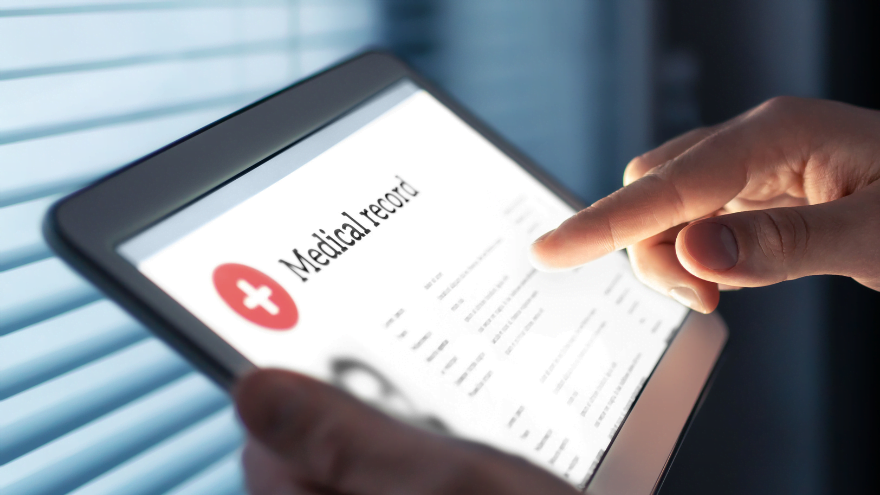Disclaimer: The information provided in this article is intended for informational purposes only and should not be construed as medical advice or professional healthcare guidance.
In the ever-evolving landscape of healthcare technology, the integration of Remote Patient Monitoring (RPM) data into Electronic Health Records (EHRs) stands as a pivotal advancement poised to revolutionize patient care delivery. With the rapid proliferation of digital health solutions and the increasing demand for personalized, proactive healthcare, the convergence of RPM data and EHR systems holds immense promise for patients, providers, and healthcare organizations alike.
This article delves into the significance, benefits, challenges, and considerations surrounding the integration of RPM data into EHRs, shedding light on the transformative potential of this innovative approach to remote patient monitoring.
The Significance of the Electronic Health Record
Electronic Health Records (EHRs) have transformed the landscape of healthcare, revolutionizing the way patient information is collected, managed, and utilized. In today’s fast-paced world, the adoption of EHR systems is not just a trend but a necessity for healthcare providers aiming to streamline operations, enhance patient care, and ensure regulatory compliance. These digital repositories of patient health information offer numerous benefits, including improved accuracy, accessibility, and efficiency in healthcare delivery.
Understanding Electronic Health Records Software
Understanding Electronic Health Records Software is crucial for healthcare professionals to efficiently manage patient data and provide quality care. Now, let’s explore the essential components and functionalities of EHR Software, pivotal in modern healthcare management.
- Backbone of EHR systems: EHR Software facilitates electronic data capture, storage, and retrieval.
- Versatile: Tailored for various healthcare settings, from clinics to hospitals.
- Comprehensive features: Includes patient demographics, medical history, diagnoses, treatments, medications, and lab results.
- Secure and user-friendly: Ensures data confidentiality while providing ease of access and navigation.
The Role of RPM Data in Healthcare
Remote Patient Monitoring (RPM) is a game-changer in modern healthcare, allowing providers to monitor patients’ health outside of traditional clinical settings. RPM devices collect vital health data, such as blood pressure, heart rate, glucose levels, and more, enabling continuous monitoring and early detection of health issues. Integrating RPM data into Electronic Health Records (EHRs) enhances the completeness and timeliness of patient records, providing a comprehensive view of their health status over time.
Benefits of Integrating RPM Data into EHRs
Enhanced clinical decision-making
By incorporating RPM data into Electronic Health Records Software, healthcare providers gain access to real-time insights into patients’ health metrics. This wealth of data enables clinicians to make more informed and proactive decisions regarding patient care, leading to better health outcomes and reduced hospitalizations.
Improved care coordination
Seamless integration of RPM data into EHRs facilitates care coordination among healthcare teams, ensuring that all providers have access to the latest patient information. This collaborative approach promotes continuity of care, reduces duplication of services, and enhances communication among care providers, ultimately benefiting the patient and optimizing resource utilization.
Patient empowerment
Empowering patients to actively participate in their healthcare journey is a key objective of RPM integration. By granting patients access to their RPM data through Electronic Health Records, they become more engaged in managing their health and can take proactive measures to maintain wellness. This increased involvement fosters a sense of ownership and accountability, leading to better adherence to treatment plans and improved health outcomes.
Streamlined workflow
Integrating RPM data directly into Electronic Health Records Software streamlines clinical workflows by eliminating the need for manual data entry and reducing administrative burden. This automation saves time for healthcare providers, allowing them to focus more on patient care and less on paperwork, ultimately enhancing efficiency and productivity within the healthcare organization.
Challenges and Considerations
While the integration of RPM data into EHRs offers immense benefits, it also presents certain challenges and considerations that need to be addressed:
Data security and privacy
Maintaining the confidentiality and security of patient health information is paramount when integrating RPM data into EHRs. Robust security measures must be implemented to safeguard sensitive data from unauthorized access, breaches, and cyber threats, ensuring compliance with HIPAA and other regulatory requirements.
Interoperability
Ensuring interoperability between RPM devices and Electronic Health Records Software is essential for seamless data exchange and integration. Standardization of data formats, protocols, and interfaces is critical to overcoming interoperability challenges and ensuring compatibility across different systems and platforms.
Workflow integration
Integrating RPM data into existing clinical workflows requires careful planning and coordination to minimize disruptions and maximize efficiency. Healthcare organizations must assess their current processes, workflows, and systems to identify opportunities for integration and optimization, ensuring smooth transition and adoption by end-users.
Overcoming Implementation Challenges
Implementing RPM data integration into Electronic Health Records Software may pose certain challenges that healthcare organizations need to address effectively:
Training and education
Healthcare providers and staff require comprehensive training and education on the use of RPM devices and the integration process with EHRs. Training programs should cover device operation, data interpretation, workflow integration, and compliance with regulatory requirements to ensure successful implementation and adoption.
Resource allocation
Effective implementation of RPM integration requires adequate allocation of resources, including financial, technological, and human resources. Healthcare organizations must invest in the necessary infrastructure, software solutions, and personnel to support the integration process and ensure its sustainability in the long run.
Change management
Managing organizational change is critical during the implementation of RPM data integration into EHRs. Healthcare organizations need to communicate effectively with stakeholders, address resistance to change, and foster a culture of innovation and collaboration to facilitate smooth transition and acceptance of the new technology.
Future Directions and Innovations
The integration of RPM data into Electronic Health Records Software opens up exciting possibilities for future advancements and innovations in healthcare:
Artificial intelligence and predictive analytics
Harnessing the power of artificial intelligence (AI) and predictive analytics, healthcare providers can leverage RPM data to anticipate and prevent adverse health events, optimize treatment plans, and personalize patient care. AI algorithms can analyze vast amounts of patient data to identify patterns, trends, and risk factors, enabling proactive interventions and improved outcomes.
Wearable technology integration
The proliferation of wearable devices, such as smartwatches, fitness trackers, and medical-grade wearables, offers new opportunities for integrating RPM data into EHRs. By seamlessly connecting these devices to EHR systems, healthcare providers can continuously monitor patients’ health metrics in real time, enabling remote monitoring, early detection of health issues, and proactive interventions.
Telehealth and remote monitoring
The integration of RPM data into EHRs complements the growing trend of telehealth and remote monitoring in healthcare. By enabling remote access to patient data and virtual consultations, healthcare providers can deliver timely and cost-effective care to patients, particularly those in underserved or remote areas. This shift towards remote healthcare delivery has the potential to improve access, convenience, and outcomes for patients while reducing healthcare disparities.
Regulatory and Ethical Considerations
As healthcare organizations embrace the integration of RPM data into EHRs, it is essential to address regulatory and ethical considerations to ensure patient privacy, safety, and compliance:
Data governance and consent
Healthcare organizations must establish robust data governance policies and procedures to govern the collection, storage, and use of RPM data within EHR systems. Patients should be informed of the types of data collected, how it will be used, and have the opportunity to provide informed consent for its use in their care.
Regulatory compliance
Healthcare organizations must adhere to regulatory requirements, such as HIPAA and GDPR, when collecting, storing, and transmitting RPM data within EHR systems. Compliance with these regulations ensures the protection of patient privacy and confidentiality while mitigating the risk of data breaches and legal consequences.
Ethical use of data
Healthcare providers must uphold ethical principles, including beneficence, nonmaleficence, autonomy, and justice, when using RPM data in patient care. Data should be used responsibly to improve patient outcomes, avoid harm, respect patient autonomy, and promote equity in healthcare delivery.
By addressing these regulatory and ethical considerations, healthcare organizations can ensure the responsible and ethical use of RPM data within Electronic Health Records Software, safeguarding patient privacy and trust while advancing the quality and efficiency of healthcare delivery.
DrKumo Solution for RPM Data Integration with EHRs
DrKumo offers a comprehensive solution for integrating Remote Patient Monitoring (RPM) data into Electronic Health Records Software (EHRs), enabling seamless data exchange, real-time monitoring, and enhanced patient care. With plug-and-play compatibility and customizable dashboards, DrKumo simplifies the integration process, empowering healthcare providers to access up-to-date patient data, generate actionable insights, and make informed decisions within the EHR interface.
By prioritizing security, privacy, and patient engagement, DrKumo’s solution ensures compliance with regulatory requirements while fostering trust and collaboration between healthcare organizations and patients. With advanced analytics, secure data management, and enhanced patient engagement features, DrKumo enables healthcare providers to deliver personalized, proactive, and patient-centered care, driving improved outcomes and efficiency in today’s dynamic healthcare landscape.
Takeaways
Integrating RPM data into Electronic Health Records Software represents a significant advancement in healthcare technology, offering numerous benefits for patients, providers, and healthcare organizations alike. By harnessing the power of real-time patient monitoring and data analytics, healthcare providers can deliver more personalized, proactive, and effective care while improving operational efficiency and patient outcomes.
Ready to revolutionize your healthcare practice with the seamless integration of Remote Patient Monitoring (RPM) data into your Electronic Health Records Software (EHRs)? Unlock the power of real-time patient monitoring and data analytics to deliver personalized, proactive, and effective care while optimizing operational efficiency and improving patient outcomes.
To learn more about how DrKumo’s innovative solution can elevate your practice to new heights of excellence in healthcare delivery. Contact us today!











